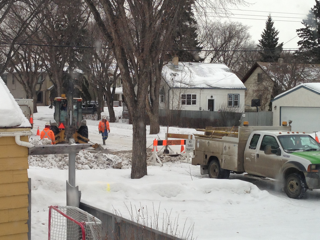In the excitement and anticipation of getting to the heart of a favourite neighbourhood, its ‘bumping place’, on a bright and fresh day hinting of spring, I lost my wallet. I had a choice: explore without any hint of purchase, or leave and go look for my wallet. The call of the wallet, more as a sense of security in knowing that it was not truly lost, won.
On Saturday, I attended Myrna Kostash‘s writing workshop hosted by the Canadian Authors Association. This little trek without my wallet started from Holy Trinity Anglican Church, where we gathered for the day, only a few blocks from Old Strathcona Farmers’ Market. I took advantage of the opportunity for an extra long lunch break to acquire fresh groceries, a walk in the fresh air and fulfill the writing task as assigned: explore the neighhourhood.
Upon arriving at the market, I made my way to a bank machine, where I realized that my wallet was not with me. I quickly made the decision to leave the market and retrace the day’s steps. I needed to both know where it is and if possible return to obtain the fresh apples and tomatoes that were calling me. I sped along the sidewalk, found my wallet, sped back to the market and proceeded to gather my needed nourishment for the week. (Here are some of Edmonton Journal photographer John Lucas’ photographs of the market, a hub for food and bumping into people.)
On my way back to the church, I noticed that I had been speeding back and forth along the same path. I noticed I had a choice I wasn’t noticing.
The physical layout of the Strathcona neighbourhood, in a grid, offers many paths of travel. I chose to go straight up the street and arrive at the church from a new angle, with a new perspective. On my new route, I quickly caught up to an elderly gent shuffling uncomfortably along the icy sidewalk. I slowed, easing myself into a new pace, simply stepping in behind him. After a few moments, the path widened, allowing me to modestly accelerate beside him, and as I did we began to chat about the state of our neighbourhood’s sidewalks.
He observed that despite a city bylaw requiring property owners to shovel sidewalks adjacent to their property, he was required to ‘rat’ on his neighbours. The City does not have the resources to scour the city for offenders, but rather awaits complaints. Complaining is what will compel neighbours to shovel and avoid the treacherous ice. In the end, we decided that it was a beautiful day and our discomfort on the ice would not last long.
This quick exchange highlighted how each neighbourhood, each place we inhabit, is a place that we create. While this gent, myself and all the surrounding residents did not build this neighbourhood one hundred years ago, we continually recreate it – even with our shovelling practices. The basic structure of the city is in place here for a walkable neighbourhood. The rest is up to us, bylaw or not.
Where is the heart of your neighbourhood?
Where do you bump into your neighbours?
_____ _____ _____
This post is part of Chapter 7 – (Un)known Possibilities, here are some plot helpers of Nest City: The Human Drive to Thrive in Cities, the book I am sharing here while I search for a publisher:
- My decision to share the book while I am working on it
- The overall structure of Nest City’s three parts
- The plot for Part 2 – Organizing for Emergence (Chapters 4-7)
_____ _____ _____
